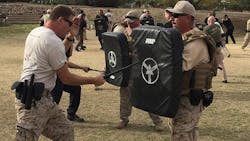ASP Trainer Talk: 3 Common Technique Questions Instructors Hear
1. Why do you teach hitting an attacker twice with the baton (Double Weapon Strike)?
The Double Weapon Strike is a combination of two basic weapon strikes. Since the baton is a defensive weapon, a single strike during a sudden attack (such as a wild punch or flurry of punches) may not stop the attack entirely or prevent subsequent attacks. The principle behind the Double Weapon Strike is the “overload principle”—which says that multiple strikes to the same side of a subject’s body can overload or disrupt the attack, so the officer can gain an advantage. The officer can create distance, evaluate the situation, establish control and apply restraints.
Remember, the goal of a physical confrontation is control. In the case of the baton, having multiple strikes/ techniques at his disposal gives the officer options. Limiting an officer to only one technique at a time may make control more difficult, or worse, may increase the risk of officer injury.
2. Why do you swing the baton from the shoulder… won’t you hit the head?
All ASP techniques are performed from the same stance. That stance doesn’t change, whether employing empty hand techniques, using an open or closed baton, handcuffing, or even using the tactical flashlight. From that base, the baton is swung on a downward 45 degree angle (from the officer’s shoulder toward his opposite hip). The target is the center mass of the subject’s weapon delivery system—most often the attacker’s arms (punches) or legs (kicks). The 45 degree angle strike intercepts these attacks, while being highly forgiving in terms of the need for precision. This increases opportunities to establish control, with a lower potential for critical or lethal injury. After striking, the baton is returned to the combat position on the officer’s shoulder, while readiness in the basic stance is maintained.
Using the sound mechanics of proper stance and angled delivery of the strike—coupled with other fundamentals of power generation—will all help to minimize the risk of striking a non-target area, especially the head.
3. Why do you handcuff with your weapon hand? I cuff with my non-dominant hand, in case I have to access my firearm.
We get this question a lot, especially at ASP Instructor Certification (AIC) courses. The most common (and in our view and experience, the best) practice is handcuffing with the dominant hand. Handcuffing is fine motor skill, and applying restraints properly, whether under stress or not, is difficult for some officers. Using the dominant hand reduces the difficulty.
If it becomes necessary to move to lethal force during the handcuffing process, we employ a principle we call “Cease to Exist.” This simple concept trains officers to discontinue a given tactic when there is a need to disengage—especially when escalating the force option. Understanding the principles behind the techniques, committing them to memory and being able to teach them to others is critical in the development of any trainer or instructor.
Reprinted with permission of ASP Inc.


